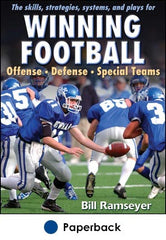Passing with a purpose: Sample quarterback drills
This is an excerpt from Winning Football by Bill Ramseyer.
Leading up to summer camp, the quarterback must pass the ball at least 250 times each day. Every pass has a purpose. Just as an archer aims precisely for the bulls-eye and not just the target, each time the quarterback passes the ball, he has a bulls-eye in mind, such as the receiver's left ear, belt buckle, or right elbow. The smaller the bulls-eye, the better. As the quarterback warms up for practice, the coach tells him the location of the desired bulls-eye.
Quarterback Warm-Up
A quarterback and receiver stand 10 yards from another quarterback and receiver. Both quarterbacks kneel next to their receivers. The ball is passed to a receiver, who hands the ball to the quarterback kneeling beside him. The quarterback passes to the receiver 10 yards away, who hands the ball to the quarterback kneeling beside him. Continue for 5 minutes.
For the second part of the warm-up, the receivers and quarterbacks remain in the same spacing, but now both quarterbacks stand with their feet parallel. They run through the same sequence: the receiver hands the ball to the quarterback next to him, and the quarterback throws to the receiver 10 yards away. The quarterback does not move his feet. Instead he throws with his upper body. Continue for 5 minutes.
In part three, the receivers move back 5 yards so they are 15 yards from the opposite quarterback. The quarterbacks step into the pass. Continue for 5 minutes.
Conclude the warm-up by bringing in a center to execute the snap. The quarterback passes from a three-step and five-step drop, sprint out, and play action. Move the receiver deeper for these passes. Continue for 5 minutes.
Coach Rush
To help the quarterback get accustomed to staying in the pocket, a coach rushes from the outside. After taking a five-step drop, the quarterback steps up into the pocket and delivers the pass.
Off-Balance Pass
Sometimes it's impossible to take a pass drop by the book. For example, if a linebacker blitz is not picked up, the pass must be executed off-balance. This can still lead to a successful play if the quarter-back rehearses it often so that when it happens in a game he reacts on instinct.
A coach rushes, and the quarterback makes the pass from an off-balance position, with something on the ball. The quarterback must consciously at-tempt to throw hard because this pass does not have his body behind it, only his arm. The receiver should be only a short distance away at first. Gradually increase the distance.
Scramble
Sometimes the only way to make a play is to scramble. Here again, there must be a plan, and the plan must be rehearsed regularly. Have a coach rush and force the quarterback to break the pocket. The receivers know to level off at whatever depth they are when the scramble begins. They then go in the same direction as the scramble, waving their arms so the quarterback finds them, and the pass is delivered. When the receiver is within 5 yards of the sideline, he turns and runs upfield.
Read Drill
This read drill involves reading whoever is responsible for the curl area. The quarterback is on the near hash with a receiver 7 yards from the sideline and 7 yards deep. This represents a player who has run a 10-yard curl and come back tight to 7 yards. Another receiver is 15 yards from the sideline and 8 to 10 yards deep, representing a receiver who has run a 10-yard curl, read the linebacker drop as being more wide than deep, and so rounded his curl behind the linebacker's drop. The read of the linebacker's drop affects where the quarterback will pass the ball. If the linebacker's drop is more deep than wide, the quarterback passes to the outside receiver. If the drop is more wide than deep, the quarterback passes to the inside receiver.
An extension of this drill is to have a receiver actually run a complete curl route and read the linebacker's drop. Run the drill daily so that the quarterback and wide receiver are consistently on the same page, reading the drop and arriving at the same point. This way the quarterback always knows what path the receiver will take, and the wide receiver always knows where the ball will be thrown.
Individual Routes Against Air
With the receivers, run all individual routes against air. Receivers run through all the routes that they use in the offense without any defensive players involved.
Learn more about Winning Football.
More Excerpts From Winning Football

Get the latest insights with regular newsletters, plus periodic product information and special insider offers.
JOIN NOW


